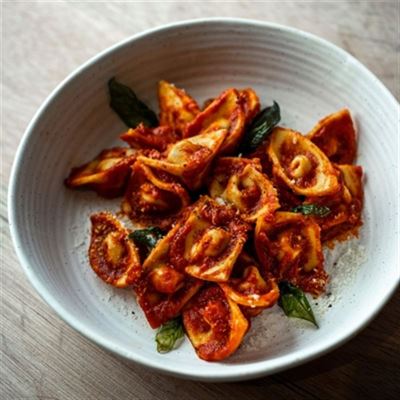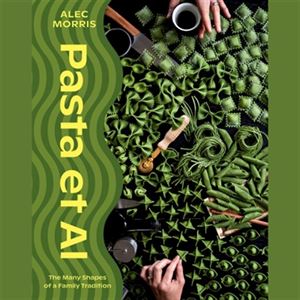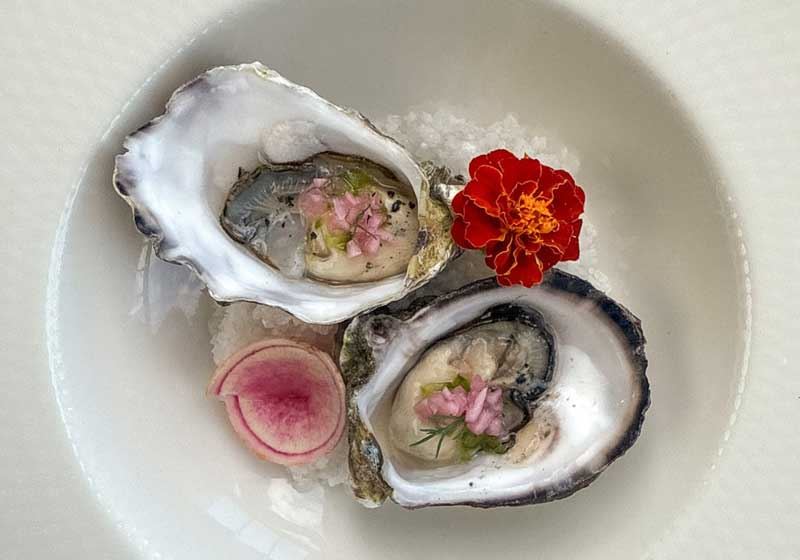Eggplant and Pecorino Tortelli with ’Nduja and Tomato - Recipe by Alec Morris
4

Ingredients
1 x quantity whole egg and egg yolk dough
Filling:
800g whole eggplant (aubergine)
40g pecorino Romano, grated, plus extra to serve
20g breadcrumbs
Juice and zest of 1/2 lemon
Salt and freshly cracked black pepper, to taste
Sauce:
60mL extra-virgin olive oil
1 small handful of basil leaves
6–8 sage leaves
4 garlic cloves, minced
700mL crushed tomatoes or passata (pureed tomatoes)
Salt and freshly cracked black pepper, to taste
1/2 tsp sugar
60g 'nduja (substitute with soft, chopped salami)
Method
Begin with the filling. Bake the eggplant directly on an oven rack at 220 C for 20 minutes.
Scoop out the flesh and drain any excess water; discard the skin. Blend together with the pecorino, breadcrumbs, lemon juice and zest, and season; transfer to a piping bag with a medium round tip.
Next, heat the olive oil in a medium-hot frying pan and fry the basil and sage leaves for 5–10 seconds until crispy. Remove the leaves from the pan and drop the heat to low.
Sauté the garlic for 2–3 minutes, stirring, before adding the crushed tomato. Season with salt and sugar, and add the ’nduja, breaking it up with the spoon as you stir. Cook for 15–20 minutes, or until the sauce has thickened and the tomato has lost its raw flavour.
While the sauce cooks, roll the pasta dough out into 1 mm sheets and cut into 6 cm squares. Squeeze a large, grape-sized dollop of filling into each and form into straight-edged tortelli (see Tortelli: Tutorial, below)
Boil the pasta until done, about 4–5 minutes, then use a slotted spoon to drop them directly into the sauce. Stir well, using a little pasta water to combine.
Serve with crispy basil and sage leaves, plenty of grated hard cheese and freshly cracked black pepper.
Tortelli:
Tortelli generally refers to filled squares or circles folded in half with the outer corners brought together to meet, much like tortellini.
There are all kinds of names for all kinds of shapes and endless disagreement that goes with it.
Here we will show you only two variations, both made from squares, although the next tutorial covers cappellacci, a sort of tortelli splinter-cell with its own variations.
To make straight-edged tortelli, sometimes called pansotti, cut fresh sheets of any egg pasta (above) approximately 1 mm thick, into squares. The size is really your preference, depending on the intensity of the filling and your intended eating experience.
We generally make ours around 6 cm across. You can also make them stand up neatly like little boats by increasing how
much the pinched corners overlap; personally, I prefer them in a lazy slouch.
Place a large dollop of filling in the middle of each, then fold in half, straight edge to straight edge, forming a rectangle with the filling in the centre. Press down on the overlapping dough to seal.
Poke gently in the side of the filling, and then bring the corners around the hollow that you just formed, overlapping slightly and pinching firmly to seal in place.
NOTE: For offset tortelli, fold in half over the filling, offsetting it so that you are left with four corners on one side and a straight edge on the other.
Poke sideways on the flat edge, then draw the outer corners around the dimple formed, to overlap slightly. The angle of overlap should approximate the angle between the other corners. Press firmly to seal.

Credits: This is an edited extract from Pasta et Al by Alec Morris published by Hardie Grant Books.
Photo Credits: This is an edited extract from Pasta et Al by Alec Morris published by Hardie Grant Books.








